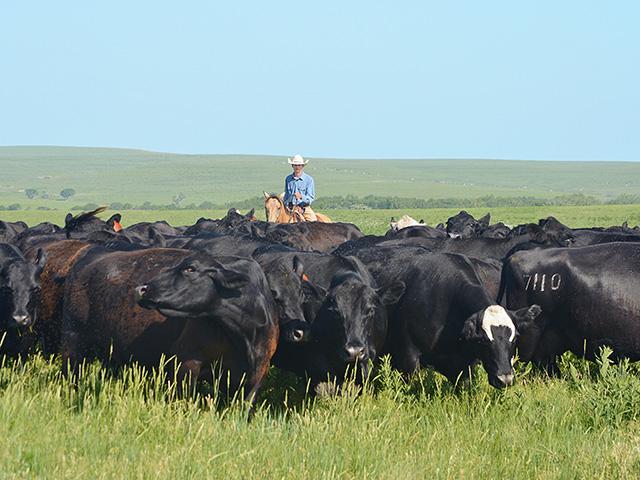Grazing Land Values Keep Climbing
Pasture, Rangeland Prices Driven Higher by Strong Commodity and Livestock Markets
Farmers National Company reported record land sales as a company for 2022, at $766 million, with most of those sales (76%) from auctions. Sellers saw land prices across Corn Belt states 20% to 34% above 2021 values, according to a report from the Kansas City Federal Reserve. And buyers, even with the steep prices, were largely still traditional farmer-operators, by a measure of some 75%.
The "I" states, as some market analysts like to refer to the Corn Belt, may have had some jaw-dropping moments this past year, but pasture and rangeland values tracked close in terms of percentage increases, across many areas.
For cattle producers, the fact that the land needed to grow forage jumped 11.5% nationally in just one year is significant. This was not far off of the national average increase for cropland, which was 14.3%.
DROUGHT AND THE RANCH LAND MARKET
Dave Hickey, an agent at Farmers National Company, has been working in the agricultural land market for 25 years. He spoke with DTN about how the market for pasture and rangeland has changed over the past year, where he is based in Nebraska.
"We have an interesting land market on the ranching side," Hickey said. "Farmland has been so robust, so strong, and we continue to see that on the tillable row crop side, both in irrigated and dryland. Typically, ranchland is a little slower to catch fire and move up along with farmland; there is always a little lag."
P[L1] D[0x0] M[300x250] OOP[F] ADUNIT[] T[]
At publication time, Hickey and another Farmers National Company agent, Robert Litz, had a large ranch in Holt County, Nebraska, listed for sale. The operation is over 11,000 acres in size and is being offered at $16.9 million. It's an eastern Sandhills ranch, with hay meadows, pastures, and excellent water. (See listing for details here: https://www.farmersnational.com/….)
Asked if listings like this are ever affected by conditions like drought, Hickey said it's possible.
"We've really had significant dry weather, and I do think it has impacted values on rangeland a little bit," he said. "Also, the cow-calf producer and the backgrounder, they are dealing with high input costs. Calf prices are finally moving in the right direction, but those guys were not all that profitable the last couple of years, so I don't think we see the same level of exuberance in that market as we do in the tillable farmland market. Today, I'd say we are seeing good interest, and we continue to move forward."
During the interview with DTN, Hickey said, "As I sit and look at 18 inches of snow on the ground, corn stalks are covered up, and guys who were relying on that for grazing know it's off the table now. A tremendous amount of hay is being fed, and by spring, we could be rationing it because of the poor hay crop we had in 2022.
"We started to get dry here in 2021, so we are a year and a half into this," he said. "The last couple of drought events I recall lasted about a year, and I'm not sure that they tremendously affected land values, if at all. This go-round, the duration and the reality of poor hay production are making more of a difference. We have higher input costs, and we're buying more feed. These are some of the realities that may cause people to pause before they make a land purchase in the ranching market."
Despite the challenges, Nebraska's ranchland values (pastureland) have fared well in national reports. And regionally, the Northern Plains, which in the USDA's Land Values Report includes Kansas, Nebraska, North Dakota and South Dakota, showed the largest percentage increases year over year for pastureland values at +17.7%. Of those states, Kansas led the way with a 23.3% increase in pasture average values, followed by South Dakota (+16%), Nebraska (+14.8%) and North Dakota (+10.7%).
PRECARIOUS TIMES AHEAD FOR THE LAND MARKET
Paul Schadegg, senior vice president of real estate operations for Farmers National Company, calls the land market today a "true supply/demand scenario."
"There are simply more buyers willing to bid on the limited amount of land coming to the market. Current commodity markets and strong cash rents provide buyers with the necessary returns to meet their investment criteria while giving them the opportunity to expand operations or add land to their investment portfolio," he said.
Land values moving into 2023 are expected to remain strong, added Schadegg. But he noted there are some drivers that will be key to where the market goes in the months ahead.
"We are cautious as interest rates continue to rise and inflation becomes a large factor in cropping inputs," he said. "These factors have the impact to decrease farm income, erode operator equity, and subsequently pressure farmland value. So, we sit at a somewhat precarious point in time where opportunity exists for both land sellers and buyers but is dependent on the continued strength of the agriculture economy to stabilize or grow."
Editor's Note: See "Auctions Fueled 2022 Land Price Surge" by DTN's Katie Dehlinger here: https://www.dtnpf.com/….
Victoria Myers can be reached at vicki.myers@dtn.com
Follow her on Twitter @myersPF
(c) Copyright 2023 DTN, LLC. All rights reserved.






